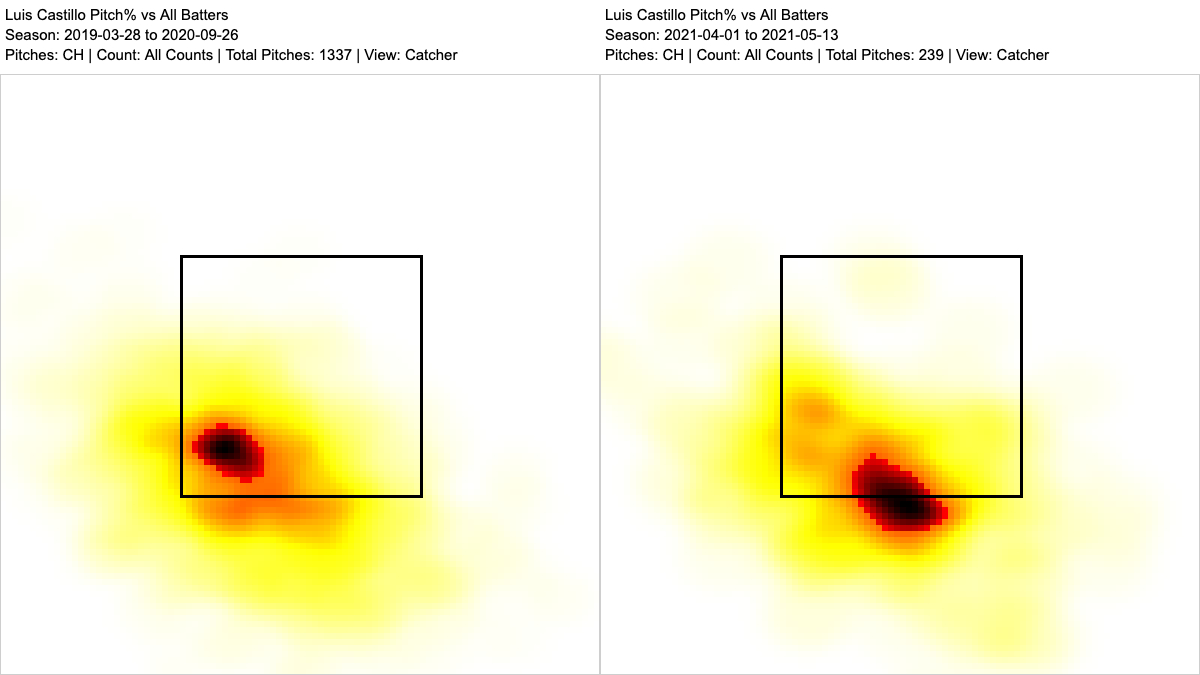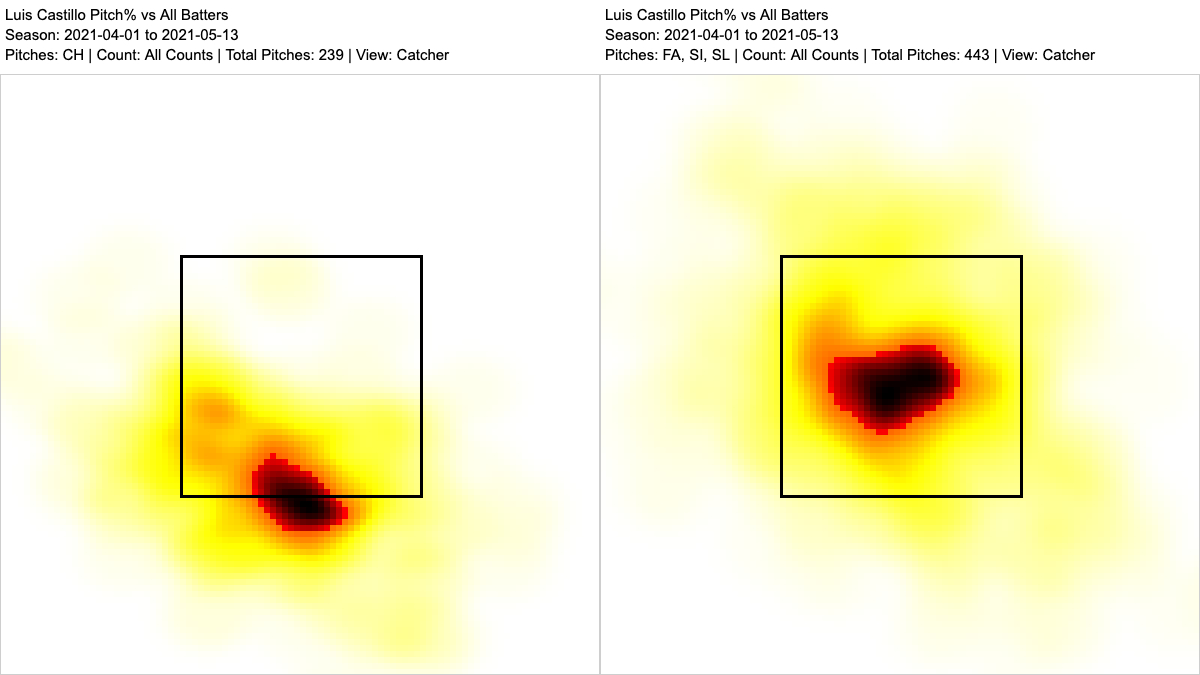Much Ado About Luis Castillo’s Changeup
At some point in your baseball fandom, you’ll end up thinking about Schrödinger’s Baseball Player. The question posed by it is simple: When does a struggling hitter or pitcher stop existing as a superposition of states – either plain unlucky or genuinely worrisome – and become one or the other?
Consider the case of Luis Castillo. Like most, I initially ignored his first few bad starts. But now, about a quarter of the way into the season, the righty’s 7.71 ERA is the worst amongst all qualified starters. Though his peripherals are much better, including a relatively respectable 4.79 FIP, you have to imagine that something is off. Maybe we should open the box and find out what.
There are a couple of things to consider regarding Castillo, but let’s focus on his changeup. Improved command of it led to a breakout season in 2019, which he followed up with an excellent 2020. A pitch with incredible movement and a penchant for missing bats, it’s the foundation of his entire repertoire. In fact, even this season, hitters have only mustered a .254 xwOBA against it, which is obviously great. So what’s the hold up? Well:
| Year | Whiff/Swing% |
|---|---|
| 2019 | 47.8% |
| 2020 | 40.1% |
| 2021 | 26.2% |
Just like that – poof! – the whiffs are gone. I’d actually be less concerned if the issue had been allowing hard contact, the data for which contains statistical noise lasting a few months. The fact that Castillo’s changeup isn’t missing as many bats, however, is a problem you can’t just attribute to a smaller sample. The Reds and Castillo himself have certainly been aware of it:
“What I’ve seen is about 70% of my pitches are staying in the zone,” Castillo said through team interpreter Jorge Merlos. “I’m definitely noticing that and I’m definitely focusing on that, too. What I’m trying to do now is pitch lower so that way we can get more swings and misses and more ground balls.”
Indeed, the heat maps of various baseball sites will tell you that his four-seamer, sinker, and slider have gained a tendency to end up over the heart of the plate. They’ve been responsible for the majority of the hard contact he’s allowed. But his changeup? It’s quite the opposite. If anything, Castillo is doing a better job at steering the pitch clear of danger:
| Year | Heart% | Shadow% | Chase% | Waste% |
|---|---|---|---|---|
| 2019 | 13.4% | 44.4% | 33.7% | 8.5% |
| 2020 | 22.3% | 42.2% | 27.2% | 8.4% |
| 2021 | 14.6% | 53.1% | 24.7% | 7.5% |
The percentage of changeups in the “Heart” region has climbed back down to 2019’s rate, while the percentage of them in the “Shadow,” corresponding to the zone’s edges, is up by nearly 10 points. Castillo is even throwing fewer changeups in the “Chase” region, which are clear balls that hitters can ignore. And yet, the swings and misses just aren’t there. Maybe we need a different angle. It’s not a matter of whether Castillo is throwing more strikes or balls, but rather where those strikes and/or balls are headed. As it turns out, there’s some merit to investigating the latter:

From down-and-in to simply down, there’s been a change in where Castillo’s changeups are generally ending up. They’re also a bit lower. That’s what he wanted to accomplish, anyways. But again, we arrive at the same conundrum – why aren’t batters getting fooled? It’s not as if where Castillo is throwing right now has always returned fewer whiffs; in 2019, he recorded a whopping 44.9% swinging-strike rate on 185 changeups there (an estimate using Baseball Savant’s zones).
Let’s shift gears. It may not seem that way, but the movement imparted to Castillo’s changeup has been changing since 2019. Below is its horizontal and vertical movement by year, along with Pitch Info’s Pitch Value per 100 metric:
| Year | Hmov | Vmov | PV/100 |
|---|---|---|---|
| 2019 | -9.4 | 0.4 | 2.73 |
| 2020 | -9.5 | -0.5 | 0.58 |
| 2021 | -9.1 | -1.0 | -0.31 |
There’s been a slight decrease in horizontal movement, but what stands out is how much vertical drop the pitch has gained over the past few years. It’s also intriguing that though Castillo’s changeup appeared perfectly fine in 2020, the Pitch Value quietly disagreed. It still does, but now loudly. Is one thing leading to the other? Honest answer: I have no idea. In theory, at least, the more a pitcher’s changeup attains vertical separation from his four-seam fastball, the more effective it becomes. So maybe it’s a positive development that has yet to pay dividends. At the same time, hitters who’ve seen the changeup countless times are now getting a different perspective, which could aid them in making contact.
This is a very good Luis Castillo changeup from 2019 (-1.57 pfx_x, 0.32 pfx_z):
And this is a not-so-good changeup from a month ago (-1.09 pfx_x, 0.03 pfx_z):
What might be the reason behind this? There’s no data for 2019, but per Baseball Savant, the percentage of active spin on Castillo’s changeup has dipped from 90% in 2020 to 79% so far. As a refresher, active spin refers to all non-gyroscopic spin contributing to a pitch’s movement. That includes backspin, which imparts an upward force that lifts the ball. If the changeup has less backspin than before, it’d make sense why it’s sinking more than expected.
Building from this, I wonder if those straight-down changeups are actually a result of Castillo’s efforts to find his sweet spot. Let’s say he wants to send a changeup down-and-in, as usual. With the pitch’s former movement, he doesn’t have much trouble accomplishing that. But what if more vertical drop is introduced? I’d imagine a pitch that was originally headed for the inside corner sinks near home plate instead. An adjustment of some sort is necessary to account for the added movement, and it’s plausible that Castillo is having trouble doing so. Between ending up somewhere by intent and by accident, the latter is far more detrimental.
We’ve only looked at the changeup in isolation, but it’s important to look at where it is in relation to his other pitches. Last year is an exemplar – his four-seamers were up, his sliders located glove-side, his changeups and sinkers to the arm-side. The variety must have made it difficult for hitters to pick up on any one pitch. But this year, that characteristic has disintegrated. On the left is a heat map of his changeups; on the right is one of Castillo’s other pitches:

There are the changeups, then there’s one big blob of pitches, straight down the pipe. It’s become easy to spot the changeup. Even if hitters can’t do damage against it, they can either take it or foul it off, then hunt for a more manageable fastball. Putting the problem this way, maybe the changeup itself is normal, but the state of everything else is influencing its ability to generate whiffs.
Still, it’s bothersome that the changeup is behaving differently than before. I’m not sure how Castillo would go about raising his active spin rate, and the information I found about wrist pronation and pulling down the seams of the ball is beyond my expertise. But alternatively, might a solution be to embrace the added vertical drop? Take a page from Jacob deGrom’s book. His changeup features better vertical movement than horizontal movement, and this season, he’s been throwing it lower and more frequently outside the zone. Any drawbacks? Hardly – hitters are continuing to chase. Earlier, I mentioned how Castillo is avoiding the Chase region of the zone, but he’s potentially missing out on valuable whiffs. With such a quality offspeed pitch, you want hitters to go after it.
Castillo’s woes are puzzling. He’s no doubt a talented pitcher, but none of his pitches have any presence. Explaining why is even tougher. There are no definitive answers, only educated guesses about which factors are relevant and which aren’t. Without a doubt, there are ones I didn’t consider. While doing research, Michael Ajeto of Pitcher List pointed out to me that Castillo’s release points are more erratic than before, which seems tied to his overall lack of command. A holistic view is necessary; I’ve narrowed in on the changeup because it’s his signature pitch. Right now, Luis Castillo exists as both a struggling ace and a pitcher beyond repair. We’ll know which state is real at some point. But how long do we have to wait?
Justin is an undergraduate student at Washington University in St. Louis studying statistics and writing.

Using my statistic xxxFIP which appeared on the community blog recently, Luis Castillo is expected to have much better results than he currently has. xxxFIP doesn’t take into account the relationship between the different pitches that a pitcher throws, it is only based on individual pitch speed, movement, and location. This implies that his struggles come from a drastic change in the way that his pitches are interacting with each other, rather than a significant change in stuff/command of any one pitch type. This agrees with the conclusion implied in the final figure in this article: that the changeup has become easier to spot.